Morus (plant)
Morus, a genus of flowering plants in the family Moraceae, consists of diverse species of deciduous trees commonly known as mulberries, growing wild and under cultivation in many temperate world regions.[1][2][3] Generally, the plant has three main species ostensibly named for the fruit color of the best-known cultivar: white, red, and black mulberry (Morus alba, rubra, and nigra, respectively), with numerous cultivars,[4] but more than 200 species are identified in taxonomy.[5] The name “white mulberry” came about because the first specimens named by European taxonomists were a cultivated mutation prized for their white fruit, but wild trees bear black fruit like other mulberries. White mulberry is native to South Asia, but is widely distributed across Europe, Southern Africa, South America, and North America.[2] It is regarded as an invasive species in Brazil and the United States.[2]
| Mulberry | |
|---|---|
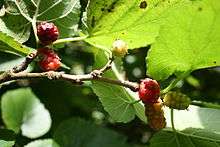 | |
| Morus nigra | |
| Scientific classification | |
| Kingdom: | Plantae |
| Clade: | Tracheophytes |
| Clade: | Angiosperms |
| Clade: | Eudicots |
| Clade: | Rosids |
| Order: | Rosales |
| Family: | Moraceae |
| Tribe: | Moreae |
| Genus: | Morus L. |
| Species | |
|
See text. | |
The closely related genus Broussonetia is also commonly known as mulberry, notably the paper mulberry, Broussonetia papyrifera.[6]
Description
Mulberries are fast-growing when young, and can grow to 24 metres (80 ft) tall.[2][4] The leaves are alternately arranged, simple, and often lobed and serrated on the margin. Lobes are more common on juvenile shoots than on mature trees.[2][4] The trees can be monoecious or dioecious.[4]
The mulberry fruit is a multiple, about 2–3 cm (3⁄4–1 1⁄4 in) long.[2][4] Immature fruits are white, green, or pale yellow.[4] The fruit turns from pink to red while ripening, then dark purple or black, and has a sweet flavor when fully ripe.[2][4]
Species
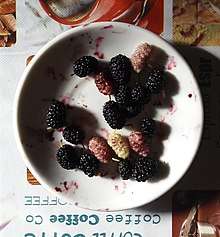
The taxonomy of Morus is complex and disputed. Fossils of Morus appear in the Pliocene record of the Netherlands.[7] Over 150 species names have been published, and although differing sources may cite different selections of accepted names, only 10–16 are generally cited as being accepted by the vast majority of botanical authorities. Morus classification is even further complicated by widespread hybridisation, wherein the hybrids are fertile.
These species are accepted by the World Checklist of Selected Plant Families as of August 2015:[5]
- Morus alba L. – White mulberry (China, Korea, Japan)
- Morus australis Poir. – Chinese mulberry (China, Japan, Indian Subcontinent, Myanmar)
- Morus cathayana Hemsl. – China, Japan, Korea
- Morus indica - L. – India, Southeast Asia
- Morus insignis - Bureau – Central America and South America
- Morus japonica Audib. – Japan
- Morus liboensis S.S. Chang – Guizhou Province in China
- Morus macroura Miq. – Long mulberry (Tibet, Himalayas, Indochina)
- Morus mesozygia Stapf – African mulberry (south and central Africa)
- Morus mongolica (Bureau) C.K. Schneid. – China, Mongolia, Korea, Japan
- Morus celtidifolia – Texas mulberry South America, Central America, Mexico, Southwestern United States
- Morus nigra L. – Black mulberry (Iran, Caucasus, Levant)
- Morus notabilis C.K. Schneid. – Yunnan and Sichuan Provinces in China
- Morus rubra L. – Red mulberry (eastern North America)
- Morus serrata Roxb. – Tibet, Nepal, northwestern India
- Morus trilobata (S.S. Chang) Z.Y. Cao – Guizhou Province in China
- Morus wittiorum Hand.-Mazz. – southern China
Distribution and cultivation
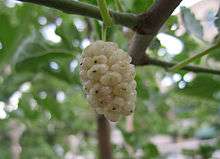
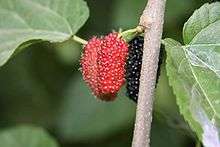
Black, red, and white mulberries are widespread in Southern Europe, the Middle East, northern Africa, and the Indian subcontinent, where the tree and the fruit have names under regional dialects. Jams and sherbets are often made from the fruit in this region. Black mulberry was imported to Britain in the 17th century in the hope that it would be useful in the cultivation of silkworms. It was much used in folk medicine, especially in the treatment of ringworm. Mulberries are also widespread in Greece, particularly in the Peloponnese, which in the Middle Ages was known as Morea, deriving from the Greek word for the tree (μουριά, mouria).
Mulberries can be grown from seed, and this is often advised, as seedling-grown trees are generally of better shape and health, but they are most often planted from large cuttings, which root readily. The mulberry plants allowed to grow tall have a crown height of 1.5 to 1.8 m (5 to 6 ft) from ground level and a stem girth of 10–13 cm (4–5 in). They are specially raised with the help of well-grown saplings 8–10 months old of any of the varieties recommended for rainfed areas like S-13 (for red loamy soil) or S-34 (black cotton soil), which are tolerant to drought or soil-moisture stress conditions. Usually, the plantation is raised and in block formation with a spacing of 1.8 by 1.8 m (6 by 6 ft), or 2.4 by 2.4 m (8 by 8 ft), as plant-to-plant and row-to-row distances. The plants are usually pruned once a year during the monsoon season to a height of 1.5–1.8 m (5–6 ft) and allowed to grow with a maximum of 8–10 shoots at the crown. The leaves are harvested three or four times a year by a leaf-picking method under rain-fed or semiarid conditions, depending on the monsoon. The tree branches pruned during the fall season (after the leaves have fallen) are cut and used to make durable baskets supporting agriculture and animal husbandry.
Some North American cities have banned the planting of mulberries because of the large amounts of pollen they produce, posing a potential health hazard for some pollen allergy sufferers.[8] Actually, only the male mulberry trees produce pollen; this lightweight pollen can be inhaled deeply into the lungs, sometimes triggering asthma.[9][10] Conversely, female mulberry trees produce all-female flowers, which draw pollen and dust from the air. Because of this pollen-absorbing feature, all-female mulberry trees have an OPALS allergy scale rating of just 1 (lowest level of allergy potential), and some consider it "allergy-free".[9]
Mulberry tree scion wood can easily be grafted onto other mulberry trees during the winter, when the tree is dormant. One common scenario is converting a problematic male mulberry tree to an allergy-free female tree, by grafting all-female mulberry tree scions to a male mulberry that has been pruned back to the trunk.[11] However, any new growth from below the graft(s) must be removed, as they would be from the original male mulberry tree.[12]
Nutrition
| Nutritional value per 100 g (3.5 oz) | |
|---|---|
| Energy | 180 kJ (43 kcal) |
9.8 | |
| Sugars | 8.1 |
| Dietary fiber | 1.7 |
0.39 | |
1.44 | |
| Vitamins | Quantity %DV† |
| Vitamin A equiv. | 0% 1 μg |
| Thiamine (B1) | 3% 0.029 mg |
| Riboflavin (B2) | 8% 0.101 mg |
| Niacin (B3) | 4% 0.62 mg |
| Vitamin B6 | 4% 0.05 mg |
| Folate (B9) | 2% 6 μg |
| Vitamin C | 44% 36.4 mg |
| Vitamin E | 6% 0.87 mg |
| Vitamin K | 7% 7.8 μg |
| Minerals | Quantity %DV† |
| Calcium | 4% 39 mg |
| Iron | 14% 1.85 mg |
| Magnesium | 5% 18 mg |
| Phosphorus | 5% 38 mg |
| Potassium | 4% 194 mg |
| Sodium | 1% 10 mg |
| Zinc | 1% 0.12 mg |
| Other constituents | Quantity |
| Water | 87.68 g |
| |
| †Percentages are roughly approximated using US recommendations for adults. Source: USDA Nutrient Database | |
Raw mulberries are 88% water, 10% carbohydrates, 1% protein, and less than 1% fat (table). In a 100 g (3.5 oz) reference amount, raw mulberries provide 180 kJ (43 kcal), 44% of the Daily Value (DV) for vitamin C, and 14% of the DV for iron; other micronutrients are in insignificant quantity.
Uses
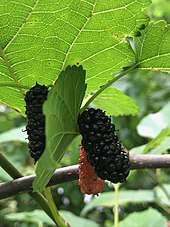
Consumption
As the fruit matures, mulberries change in texture and color, becoming succulent, plump, and juicy, resembling a blackberry.[4] The color of the fruit does not distinguish the mulberry species, as white mulberries may be white, lavender or black in color. White mulberry fruits are typically sweet, but not tart, while red mulberries are usually deep red, sweet, and juicy. Black mulberries are large and juicy, with balanced sweetness and tartness.[4]
The fruit of the East Asian white mulberry – a species extensively naturalized in urban regions of eastern North America – has a different flavor, sometimes characterized as refreshing and a little tart, with a bit of gumminess to it and a hint of vanilla.[14] In North America, the white mulberry is considered an invasive exotic and has taken over extensive tracts from native plant species, including the red mulberry.[2][15]
Mulberries are used in pies, tarts, wines, cordials, and herbal teas.[2][4] The fruit of the black mulberry (native to southwest Asia) and the red mulberry (native to eastern North America) have distinct flavors likened to 'fireworks in the mouth'.[14]
As a supplement
The fruit and leaves are sold in various forms as dietary supplements. Unripe fruit and green parts of the plant have a white sap that may be toxic, stimulating, or mildly hallucinogenic.[16]
Silk industry
Mulberry leaves, particularly those of the white mulberry, are ecologically important as the sole food source of the silkworm (Bombyx mori, named after the mulberry genus Morus), the cocoon of which is used to make silk.[17][18] The wild silk moth also eats mulberry.[19][20] Other Lepidoptera larvae—which include the common emerald, lime hawk-moth, sycamore moth, and fall webworm—also eat the plant.[21]
Pigments
Mulberry fruit color derives from anthocyanins,[3] which have unknown effects in humans.[22] Anthocyanins are responsible for the attractive colors of fresh plant foods, including orange, red, purple, black, and blue. [22] These colors are water-soluble and easily extractable, yielding natural food colorants.[2] Due to a growing demand for natural food colorants, they have numerous applications in the food industry.[3][22]
A cheap and industrially feasible method has been developed to extract anthocyanins from mulberry fruit that could be used as a fabric dye or food colorant of high color value (above 100).[2] Scientists found that, of 31 Chinese mulberry cultivars tested, the total anthocyanin yield varied from 148 to 2725 mg/l of fruit juice.[23] Sugars, acids, and vitamins of the fruit remained intact in the residual juice after removal of the anthocyanins, indicating that the juice may be used to other food products.[23][2]
Mulberry germplasm resources may be used for:[3][2][24]
- exploration and collection of fruit yielding mulberry species
- their characterization, cataloging, and evaluation for anthocyanin content by using traditional, as well as modern, means and biotechnology tools
- developing an information system about these cultivars or varieties
- training and global coordination of genetic stocks
- evolving suitable breeding strategies to improve the anthocyanin content in potential breeds by collaboration with various research stations in the field of sericulture, plant genetics, and breeding, biotechnology and pharmacology
Paper
During the Angkorian age of the Khmer Empire of Southeast Asia, monks at Buddhist temples made paper from the bark of mulberry trees. The paper was used to make books, known as kraing.[25]
Tengujo is the thinnest paper in the world. It is produced in Japan and made with kozo (stems of mulberry trees).[26]
In culture
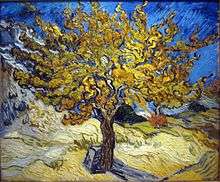
A Babylonian etiological myth, which Ovid incorporated in his Metamorphoses, attributes the reddish-purple color of the mulberry fruits to the tragic deaths of the lovers Pyramus and Thisbe. Meeting under a mulberry tree (probably the native Morus nigra),[27] Thisbe commits suicide by sword after Pyramus was killed by the lioness because he believed that Thisbe was eaten by her. Their splashed blood stained the previously white fruit, and the gods forever changed the mulberry's colour to honour their forbidden love.[27]
The nursery rhyme "Here We Go Round the Mulberry Bush" uses the tree in the refrain, as do some contemporary American versions of the nursery rhyme "Pop Goes the Weasel".
Vincent van Gogh featured the mulberry tree in some of his paintings, notably Mulberry Tree (Mûrier, 1889, now in Pasadena's Norton Simon Museum). He painted it after a stay at an asylum, and he considered it a technical success.[28]
Gallery
- Clusters (inflorescences) of unopened female flower buds
 Mulberry flower clusters
Mulberry flower clusters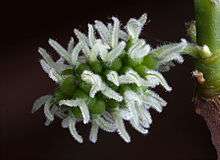 Female flower clusters
Female flower clusters Unripe white mulberries
Unripe white mulberries Semi-ripe mulberries on a mulberry leaf
Semi-ripe mulberries on a mulberry leaf A mulberry tree in England
A mulberry tree in England- Autumn foliage
References
- J.M. Suttie (2002). "Morus alba L." United Nations, Food and Agriculture Organization. Retrieved 8 March 2020.
- "Morus nigra (black mulberry)". CABI. 20 November 2019. Retrieved 8 March 2020.
- James A. Duke (1983). "Morus alba L., Moraceae: White mulberry, Russian mulberry, Silkworm mulberry, Moral blanco". Handbook of Energy Crops. Archived from the original on 2012-10-28. Retrieved 8 March 2020.
- "Mulberry". California Rare Fruit Growers. 1997. Retrieved 8 March 2020.
- "Search for Morus". The Plant List, Kew Botanic Gardens. 2013.
- Wunderlin, Richard P. (1997). "Broussonetia papyrifera". In Flora of North America Editorial Committee (ed.). Flora of North America North of Mexico (FNA). 3. New York and Oxford – via eFloras.org, Missouri Botanical Garden, St. Louis, MO & Harvard University Herbaria, Cambridge, MA.
- Martinez Cabrera HI; Cevallos-Ferriz SRS (2006). "Maclura (Moraceae) wood from the Miocene of the Baja California Peninsula, Mexico: Fossil and biogeographic history of its closer allies". Review of Palaeobotany and Palynology. 140 (1–2): 113–122. doi:10.1016/j.revpalbo.2006.03.004.
- City of El Paso (July 10, 2007). "Agenda item department head's summary form" (PDF). Retrieved 21 July 2014.
- Ogren, Thomas Leo (2000). Allergy-Free Gardening. Berkeley, California: Ten Speed Press. ISBN 1580081665.
- Wilson, Charles L. "Tree pollen and hay fever". Food and Agriculture Organization. Retrieved 17 May 2014.
- Ogren, Thomas Leo (2003). Safe Sex in the Garden: and Other Propositions for an Allergy-Free World. Berkeley, California: Ten Speed Press. pp. 22–23. ISBN 1580083145.
- Phipps, Nikki. "Can Grafted Trees Revert to Their Rootstock?". Gardening Know How. Retrieved 16 May 2014.
- "Rubus brasiliensis - Amorinha". FloraSBS (in Portuguese). Retrieved 2018-05-18.
- "which mulberry to buy. advise me!". The Cloudforest Gardener. Archived from the original on 2013-06-08.
- Boning, Charles R. (2006). Florida's Best Fruiting Plants: Native and Exotic Trees, Shrubs, and Vines. Sarasota, Florida: Pineapple Press, Inc. p. 153.
- "White mulberry – Morus alba". Ohio Perennial and Biennial Weed Guide. The Ohio State University. Archived from the original on 2012-04-12. Retrieved 20 October 2012.
- Ombrello, T. "The mulberry tree and its silkworm connection". Plant of the Week. Cranford, NJ: Union County College. Archived from the original on 2012-10-19. Retrieved 2012-10-20.
- "Mulberry silk". Central Silk Board, Ministry of Textiles - Govt of India. Retrieved 20 October 2012.
- Bisch-Knaden, Sonja; Daimon, Takaaki; Shimada, Toru; Hansson, Bill S.; Sachse, Silke (January 2014). "Anatomical and functional analysis of domestication effects on the olfactory system of the silkmoth Bombyx mori". Proceedings of the Royal Society of London B: Biological Sciences. 281 (1774): 20132582. doi:10.1098/rspb.2013.2582. ISSN 0962-8452. PMC 3843842. PMID 24258720.
- Tanaka, Kana; Uda, Yusuke; Ono, Yukiteru; Nakagawa, Tatsuro; Suwa, Makiko; Yamaoka, Ryohei; Touhara, Kazushige (9 June 2009). "Highly Selective Tuning of a Silkworm Olfactory Receptor to a Key Mulberry Leaf Volatile". Current Biology. 19 (11): 881–890. doi:10.1016/j.cub.2009.04.035. ISSN 0960-9822. PMID 19427209.
- Tang, Rui; Zhang, Feng; Zhang, Zhong-Ning (June 2016). "Electrophysiological Responses and Reproductive Behavior of Fall Webworm Moths (Hyphantria cunea Drury) are Influenced by Volatile Compounds from Its Mulberry Host (Morus alba L.)". Insects. 7 (2): 19. doi:10.3390/insects7020019. ISSN 2075-4450. PMC 4931431. PMID 27153095.
- "Scientific opinion on the substantiation of health claims related to various food(s)/food constituent(s) and protection of cells from premature aging, antioxidant activity, antioxidant content and antioxidant properties, and protection of DNA, proteins and lipids from oxidative damage pursuant to Article 13(1) of Regulation (EC) No 1924/20061". EFSA Journal. EFSA Panel on Dietetic Products, Nutrition and Allergies. 8 (2): 1489. 2010. doi:10.2903/j.efsa.2010.1752.
- Liu X, Xiao G, Chen W, Xu Y, Wu J (2004). "Quantification and purification of mulberry anthocyanins with macroporous resins". Journal of Biomedicine & Biotechnology. 2004 (5): 326–331. doi:10.1155/S1110724304403052. PMC 1082888. PMID 15577197.
- "Morus alba L." US Department of Agriculture, National Plant Germplasm System. 2020. Retrieved 8 March 2020.
- Chhem KR, Antelme MR (2004). "A Khmer Medical Text The Treatment of the Four Diseases Manuscript". Siksācakr, Journal of Cambodia Research. 6: 33–42.
- Whang, Oliver (May 5, 2020). "The Thinnest Paper in the World". The New York Times. Retrieved 9 May 2020.
- Reich, Lee (2008). "Morus spp. mulberry". In Janick, Jules; Paull, Robert E. (eds.). The Encyclopedia of Fruit and Nuts. CABI. pp. 504–507. ISBN 9780851996387.
- Gogh, Vincent van (1889). "Mulberry Tree". van Gogh Collection. Norton Simon Museum, Pasadena, California. Retrieved 20 October 2012.
External links
| Wikispecies has information related to Morus (Moraceae) |
| Wikimedia Commons has media related to Morus. |
| Wikisource has the text of The New Student's Reference Work article "Mulberry". |
- Flora of China: Morus
- Flora of North America: Morus
- Sorting Morus names (University of Melbourne)
- Propagation (growing) by vegetative method
- Propagation (growing) by seed method
- photo of 300-year-old Japanese mulberry
- Central Sericultural Germplasm Resources Centre, Ministry of Textiles, Government of India
- Replant a mulberry tree: article from Times of India
- The Morus Londinium project - Mulberry tree heritage in London, UK